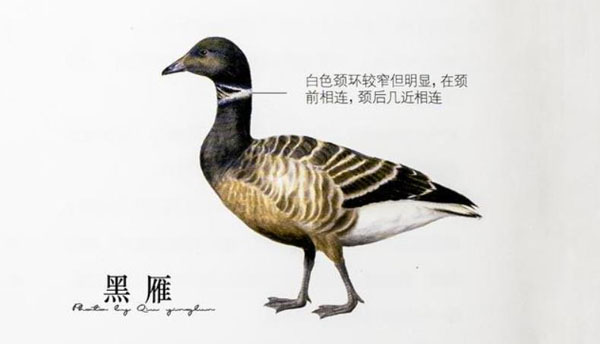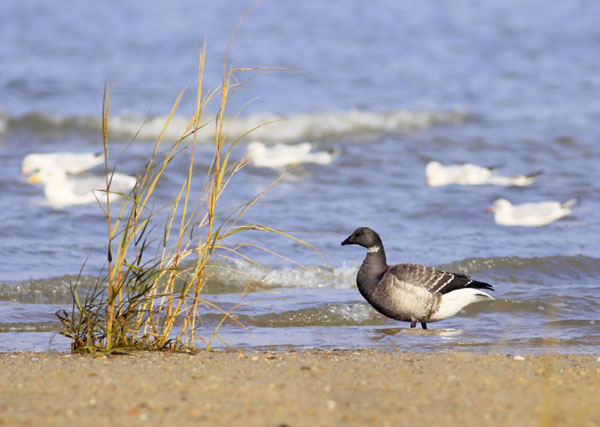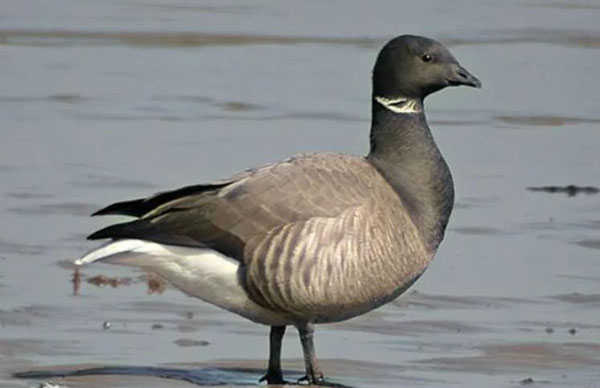Branta bernicla
IUCN
LCBasic Information
Scientific classification
- name:Branta bernicla
- Scientific Name:Branta bernicla,Brent Goose
- Outline:Waterfowl
- Family:Aneniformes Anatidae Brancus
Vital signs
- length:56-61cm
- Weight:1100-1700g
- lifetime:13years
Feature
Medium sized dark grey goose. Black beak and feet, white undertail feathers.
Distribution and Habitat
In China, it is a winter migratory bird, mainly wintering in the Bohai Sea and the Yellow Sea coast in the northeast and east, and some as far south as Fujian and Taiwan Island. Foreign breeding in the northern border north of the Arctic Circle and the Arctic Ocean coast and surrounding islands, winter in the northern central coastal and estuarine areas.
It inhabits coastal waters with many aquatic plants in winter and feeds on coastal swamps and beaches. Stray birds or mix with other geese and large ducks.
Appearance
The head and neck chest are all black, which is different from other barnacle geese. The upper neck side has white patches, the wings have white stripes, the flanks and lower abdomen are stained white, the lower tail feathers are white, and the rest of the tail is gray black. Iris dark brown, beak black, feet gray black.
Details
Brants are typical cold-water Marine birds, tolerant of cold, and prefer to live in bays, harbors and estuaries. Don't mix with other species. Flies low near the water surface and lives in coastal harbors during high tides. Foraging on coastal pastures. Mainly to grass or aquatic plants buds, leaves, stems, etc. for food, but also eat roots and plant seeds, and sometimes eat wheat seedlings and other crops in winter. Migration often integrates large groups, flying during the day, and landing in the evening to rest and forage in lakes and other waters, often making high calls and extremely noisy.

Sex is very active, like clusters, often group activity and habitat. When flying, the two wings incite quickly and strongly, and issue a "whirring" sound. Usually flying in a straight line, but often circling and flying back and forth over the sea; Turns are also very flexible. More than a single line when flying, sometimes also a dense, scattered, like a swarm of bees close to the ground flight. He is also good at running on the ground, quick in action, very fast, and very light in swimming. When swimming, the front is sinking, the back is protruding upward, the tail is very high above the water, and the white under the tail is obviously visible. Good at swimming and diving, flying speed is also very fast, flying from the surface of the water, is always constantly chirping. At night, they usually live on the water, in shallow water near the water, or on the beach. Every day they fly to the grassland in groups at dawn to feed, return to the water at noon to rest, drink and eat sand, and sometimes roost in the feeding ground at night. When the climate is bad, especially when there is a storm, they often take shelter in the reeds. Don't mix with other species.

It feeds mainly on plant foods. When they first move to their breeding grounds, they feed mainly on moss and lichen beneath the rocks because the ice and snow have not melted. As temperatures rise and the plants begin to shade, they begin to forage in abundance for regrowing shoots, stems and leaves. In autumn and winter, they forage for eelgrass and seaweed on the coast, and are completely vegetarian, feeding on algae, mosses, lichens, summer seagrasses, sallow seeds, green algae, grain seeds, and young winter wheat seedlings. They feed mainly in the early morning and afternoon. The breeding season mainly feeds on tundra ground, and the non-breeding season feeds on coastal and coastal mud. Feeding methods In addition to the general head and neck into the water to feed, they can also like some ducks in shallow water, tail up into the water to feed on the bottom.
Barngeese are typical migratory birds. Among them, barnlings distributed in China mainly migrate between the breeding grounds in the Arctic tundra of Siberia and the wintering grounds in the Yellow Sea, East China Sea and Bohai Bay of China, as well as the coasts of Korea and Japan. Most people move to China between late September and early December. The time to move away from China's coastal areas was from early April to mid-April, or as late as early May.

Barnacle geese breed in the Arctic tundra. When they move to the breeding ground, the ice and snow have not melted, and they often inhabit the ice and snow in groups. Pairings usually form after arrival at the breeding grounds, but mating and aerial chasing have been evident in the wintering grounds. The courtship behavior is preceded by mutual head immersion movement, but there is no obvious vertical rearing of the tail as in other geese, followed by the male goose stretching his neck and calling, but no obvious ritualized movements. After reaching the breeding ground in groups, they are often concentrated on the coastal shore, moving freely on the ice and snow. After the pair is formed, the male birds gradually leave the group under the lead of the female. Find a suitable place to nest. They usually nest in pairs or small groups together to breed, and the nests are mostly chosen in some coastal islands or ponds and streams along the coast, and there are also nests on the shore of lakes. Nesting sites are usually covered with grass or reeds. The nests are mostly located in dry areas of coastal swamps or tundra, or on mounds and bank slopes. The nests are often formed by digging holes in the ground, or by the female stepping into a small hole in the soft tundra with moss, bird feathers and feather feathers.








